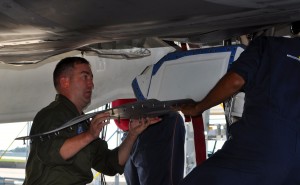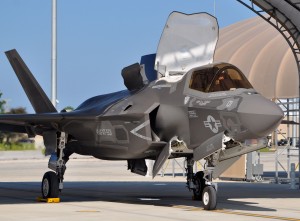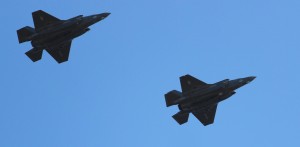2012-09-16 By Robbin Laird
During my visit to Eglin AFB on August 24, 2012, I had a chance to continue my ongoing conversation with Deputy Commander of the 33rd Fighter Wing, Col. Tomassetti.
In previous visits, Tomassetti showed me the plan, then the buildings being constructed, the classrooms being formed, the courseware being written and the preparation for pilots, maintainers and planes to show up.
Now they have shown up and it was a real pleasure to see the ITC in operation and to witness the 200th sortie of the F-35 at Eglin.
In January 2010, Tomassetti outlined the approach of the ITC and its strategic advantages:
We’re going to have representatives from all three services in the U.S. and whatever partner countries are here at Eglin, and those students, without us doing anything deliberate or specific, are going to be going to the same classrooms, sitting next to each other. They’re going to go and they’re going to eat breakfast and lunch together in the same dining areas potentially. They’re going to go run in the same jogging rails. They’re going to go workout in the same fitness facilities.
So without even trying, there’s going to be an interchange of cultural ideas and philosophies. There’s going to be an interchange of how we do business, how they do business. There’s going to be an interchange of all kinds of basic information that those students will just naturally gravitate to as they’re exposed to being in close proximity to each other.
So that’s without even trying. Now if you say, “Okay, what if we put a little bit of effort and thought into that?” How much more could we get out of that where we deliberately setup training events that will make Navy, Marine, and Air Force pilots go fly training missions together as they get into their advanced studies where multiple airplanes are required and we allow them to share their ideas and their service techniques of doing things and then add in the partner countries that take part in this. The opportunity to learn and increase the knowledge base of everybody who comes through the Eglin campus is tremendous.
During this visit, I bumped into a British Royal Naval maintainer now at Eglin and beginning his training. The promise is starting to be realized.
Question: How many planes are here now?
Tomassetti: We currently have 19 F35s here at Eglin; 10 F35Bs and nine F35As. We started flying the F35As in March, and we started flying the F35Bs at the end of May.

Question: What are the initial results of the training effort?
Tomassetti: The initial results are very good. From the pilot perspective, I gauge success on two primary things. One is when a pilot steps out to the airplane for the first time and flies the aircraft. You have to remember that we have no two-seat versions of the F35, so when they go the first time, they’re going solo.
When they walk out to the airplane and they’re confident, that’s one positive indication. That means that we have done enough to make them feel confident in terms of what we’ve taught them in the classroom, what we’ve shown them in the simulator.
When they get back from that first flight and say that nothing was surprising, that the airplane pretty much flew like the simulator did, that everything worked as it did in their rehearsal simulator for the first flight, that’s my other measure of success.
That means that if we have now confidence in that ground training that it’s accurate.
It is very representative of the real aircraft, and that we’ve done a good job in giving them enough detail, enough breadth of information so they feel comfortable in the airplane, and they are prepared to handle any contingency.
And it means that we have done the right things in the simulator in terms of making it realistic.
And in terms of what we actually expose them to in the simulator so that when they do that first flight, there are no surprises. Again, everything is just like it was in the simulator when they go out and fly the airplane on that actual flight.
In the beginning, we were happy when we could fly about two or three sorties per week on our airplanes. We were very excited towards the month of June when we were able to execute eight sorties in the same week, which was our first milestone event because that was the sortie generation rate we would need to train a group of four pilots in the block 1A syllabus and keep them on schedule.
And just a month and a half, two months down the road now, we’re now scheduling eight sorties a day fairly routinely.
We have come a long way in the past few months.
The maintainers are getting smarter about how to handle them. General operating the airplanes here at Eglin is getting to be somewhat routine; so the pilots are getting more comfortable, the installation, air traffic control is getting more comfortable with us operating in the air.
Question: What is next in terms of the training effort?
Tomassetti: We are injecting two UK pilots into the curriculum this Fall and Dutch pilot next year.
And we are shifting curriculums. The current curriculum focuses on the basics of flying the aircraft. The new syllabus goes beyond that to the use of the combat systems aboard the aircraft. We start to incorporate simulated weapons, we start to incorporate the radar and some of the other sensors on the airplane, and teac the pilot not just how to fly the airplane but how to fight with the airplane.
Question: And this shift in curriculum is associated with the upgrade process on the aircraft itself?

Tomassetti: We’ve started to modify some of those initial block 1A airplanes to the block 1B configuration. This involves both software and hardware changes to the airplane, but what it brings us a capability to continue executing additional flights in the overall F35 syllabus.
The initial block 1A syllabus consisted of six flights, basically, for the pilots. As we get the full capability of block 1B enabled in the airplanes and cleared for use, we will be up to training about 27 flights on the F35B syllabus.
It’s a pretty substantial jump in what we can execute of what will be eventually about a 50-flight syllabus in the block 3 configuration.
It is a small step with block 1A, and a bigger step with block 1B. The biggest thing we bring in with block 1B is we start to bring in some of the war fighting capability of the airplanes, some of the sensor capability of the airplane, and so to introduce the pilots to how to use those sensors, how to employ some of that combat capability.
And that’s what we’re working towards right now is to get those airplanes converted, get our block 1B syllabus, our courseware and our simulator program reviewed and certified that it’s good to go. And then hopefully, by the beginning of 2013, we’ll have all that process done. And we’ll be training pilots in block 1B and block 1A will be in the rearview mirror.
Question: You are going to leave by next summer. What would you like to see by the time you leave?
Tomassetti: I think from a personal perspective, what I’d like to see happening here at Eglin before I leave is that we are basically into sustained training operations, for both pilots and maintainer.
Matter of course may be a little bit too strong a term, but the process becoming very predictable and very regular would be the goal.
We are advertising to our customers, the Marine Corps, the Navy and the Air Force that we can train a certain number of people in a given time frame, a fiscal year typically is what we use.
And they are sending us people on a regular basis, every couple of weeks, and we’re starting a new class of some number of pilots and maintainers. They are executing their training, and they are staying within the prescribed amount of time to complete that training.
And we’re sending them off to wherever it is they’re destined to go.
And at the very end of it, wherever they go, I would like those people coming and telling us that we developed a pretty high quality product.
Keep up the good work. That’s where I’d like to see us next summer and to have the initial people out the door, working wherever it is they’ve been sent to work.
Question: It is clear that the Marine Corps as the initial operator of the aircraft have a special role within the program. What is the relationship between Eglin and the roll out to Yuma and Beaufort?
Tomassetti: One of the Marine pilots who is here was selected to be the commanding officer of 121 out in Yuma. So we’re already starting to see the Marine Corps reach into the Eglin training pool.
We’ll mix in some experienced people from Eglin and they’ll bring in some new folks as well with some fresh ideas to shape the new USMC squadrons.
We are not only taking some of the folks from here and getting them ready to populate those places with their expertise, but we’re doing a lot of work now trying to bring in as many people as we can from Yuma. We let them spend a couple of days here, learning what a day in the life at Eglin is like, or a day in the life of F35 operations is like. This way, they can see things and take that back to Yuma and inform the folks there.
And there is cross-fertilization across the test and training sites; between here, Pax River and Edwards.

Question: Could you talk about the software on the plane and explain the importance of software stability for a fly by wire airplane?
Tomassetti: It’s very easy when you talk about airplanes, especially, in the 21st century to talk about things like weapons capability, speed, turning capability, maneuverability, and low observability.
But what you don’t hear many people talk about is it an easy airplane to fly?
Pilots make that comment oh, this is an easy airplane to fly and that’s sometimes taken for granted, and the understanding of what it takes to make an airplane that’s easy to fly.
This is especially the case when we talk about F35, an airplane that has to fly as a conventional airplane, that has to fly as a STOVL airplane, it has to be able to perform carrier approaches and carrier landings.
Trying to make all of those different types of flying that the F35 has to do, fall into that category of easy to fly is no small achievement.
With the F35B, right now, we have seen pilots with no Harrier background, with no Harrier experience, with no STOVL experience, get in the airplane after their first time and say that was pretty easy to fly in the STOVL mode.
We have lots of visitors here at Eglin and we get a chance to put many of them in the simulators. And one of the things that we do with everybody is we let them do a vertical takeoff, fly around and come back and do a vertical landing, either at the fuel or at the ship.
And the comments from everybody from heads of state, chiefs of staff, or foreign folks, folks with lots of flying experience to folks with next to no flying experience and they come back from the simulator and say well, that was pretty easy to do.
That was what the engineers were hoping would happen, and that’s what a lot of years and a lot of testing and analysis and research was put in place to allow to happen. And I think we’ve actually achieved it.
I think we finally built the STOVL aircraft that we’ve been trying to build for about six decades.
We have an airplane that is comparable to its conventional counterpart that has all of the capabilities that its conventional counterpart has. It doesn’t really sacrifice much in the way of significant capabilities in order to retain its STOVL capability.
And for that STOVL capability, we have an airplane that’s easy to fly, which means we won’t spend a lot of time having to teach people how to fly STOVL. And we won’t spend a lot of time practicing STOVL when we’re out there.
We will spend the majority of our time with this airplane focusing on tactics and missions.
I can tell you from a training perspective, if I’m spending more time teaching someone how to fight with the airplane, then on how to fly the airplane, I’m giving the fleet a much better pilot, a much better combat ready pilot at the end of the day.
I think that’s worth however many lines of code it takes, and however many hours in the laboratory it took to get there, it was worth every minute of it, and worth every line of code that we got to enable that to happen.


